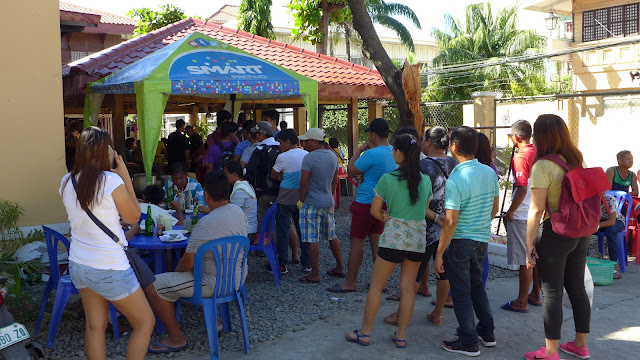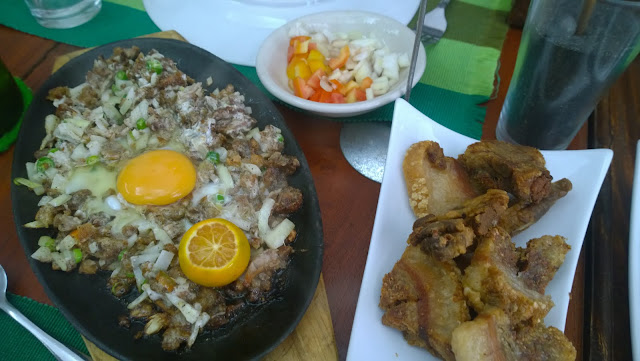Dinakdakan, insarabasab, poqui poqui, dinardaraan, igado, pakbet, bagnet, empanada, papaitan --
I think I've pretty much run the gamut (oh yes, and let's not forget gamet!) of dishes from Region 1. All delicious, all homegrown, all uniquely Ilocano.
But I had yet to try sinanglaw -- a beef soup dish essentially using economical cuts of beef plus beef innards that has its beginnings and roots in Vigan City.
On this last trip, the Ilocano food gods were specially kind. Vigan's best sinanglawan was located right smack in front of Veneto de Vigan, our hotel for the week-end.
Appropriately named 1st Sinanglaoan, this makeshift eatery is located inside the compound of the Vigan Post Office.
A long queue could be observed each morning and the hotel staff told me that if I wanted to grab a bite, I should go very early for the place was open only from 6 until all the sinanglaw ran out, usually well before lunch time.
There is an alarm implanted in my brain that screams "Wake up for food!"!
Next morning, I showed up bright and early at a little past 6 but found myself fifth in line.
I was quite surprised to see that most of the tables were occupied and people were happily slurping away.
Two ladies were at the front line -- manning the large constantly simmering kalderos of boiled meats -- one for the laman made up of the cheaper cuts of beef and the other for the laman loob (offal).
Sinanglaw is head to tail eating, Ilocano style -- every unwanted bit of the cow is used so nothing is wasted and the animal does not give up its life in vain.
This kaldero station is where you order your bowl of sinanglaw. The friendly hotel staff
had told me to ask for both laman and tripilya or tripe. Unfortunately there was no tripe that
morning but the kind Manang told me she had something better.
She picked out a huge chunk of puso or beef heart. Along with a slab of laman which was actually
beef cheeks (my old and dear friend carrillera) my bowl had chunks of coagulated beef blood and bits and pieces of kidneys, liver and pancreas. Manang put in two strips of beef skin "para matikman mo" she said.
Since I had both laman and laman loob, this counted as a double order. A regular order is just of either one.
Here's helpful Manang with my bowl. Soup refills are de rigueur and on the house.
Now that I had my bowl, I loaded it on a tray and lined up for my plate of steaming hot, freshly cooked rice. This assembly line works very efficiently! Right beside the rice is the "cashier" who looks over your order and tells you how much you owe.
My double order of sinanglaw, (single) rice and bottled water cost me all of P125. Such a great bargain for all this food.
I took a first sip of the broth -- it was light yet you could taste the hearty beef flavour.
I was expecting it to taste like bulalo but sinanglaw has a faint but unmistakeable tartness which brought to mind the Ilonggo kansi. I later found out from Manang that kamias is what adds the
sour to sinanglaw.
This lingering tart note makes the broth quite refreshing and keeps it from overwhelming your mouth with all that cow-iness. I immediately loved it! It reminded me of sinigang and paksiw, two dishes that rank high on my list of "Food I Could Eat Everyday".
The Manangs at the sinanglawan were watching me and quickly caught on that they had a "newbie"
on their hands.
They swooped down on me before I committed the ultimate mistake of eating my sinanglaw the wrong way.
I was not aware that there is a ritual that involves specific sauces and condiments that are essential
to savoring sinanglaw.
One is sukang Iloko made extra hot with siling labuyo (bird's eye chili) which is used as sawsawan
or dipping sauce. The other must-have is a dark olive green sauce made of bile called pespes.
Bottles of these sauces are on each table but the very nice Manang even got me a new bottle of pespes, one that was quite warm to the touch. Oooh, very freshly harvested bile! Just what I needed
to kickstart my day.
Raw sliced onions are the third condiment in the sinanglaw triumvirate but I drew the line at that.
The sukang Iloko is for dipping but the pespes or bile sauce is mixed in with the broth.
I was told to use a tablespoon at first then add more to suit my taste. The pespes turned the soup a little bit darker and added a depth of flavour that Manang assured me is the true taste of Vigan sinanglaw. I was afraid that bile would turn the soup too bitter but it blended and enhanced all the complex flavours of boiled offal and meat.

Having given an all thumbs up to the broth, it was time to try the various cuts of meat in my bowl.
Vegetarians -- look away please!
See those two large blocks of meat? The one with more fat attached is the beef heart. The other piece is beef cheeks. The dark brown squares are coagulated beef blood. This was a delicious discovery as the blood had no mineral-ly taste at all. Manang said that before cooking, they
season the blood which accounts for its delicate flavour.
My first slice was from the rather large slab of beef heart. The heart was solid and thick and looked like it would be tough (I was prepared to be chewing like a cow) but the knife cut through easily. How did it taste? Absolutely divine!
The texture was smooth (this was certainly a tender-hearted cow) and while it didn't exactly melt in the mouth, it was surprisingly easy to chew.
Here's a close up of my first slice of the beef heart. Can you see those little holes -- they must be
the arteries of the heart. It didn't seem blocked to me so it must have been a healthy cow. However, I wasn't too sure about myself, after ingesting all that protein!

Sinanglaw uses mostly meat from the cow's face so if you ask for laman, chances are you'll be given beef cheeks or carrillera. These are economical but are generally a tough cut so you need to cook them for a long time. I cook beef cheeks in red wine until it's fork tender and when soft, it almost has the taste and texture of lengua or beef tongue, which costs a whole lot more.
My generous piece of carrillera must have been tenderised over a long, slow fire since the wee hours of the morning.
Here are the Manangs who were so friendly and took me under their wing ... showing me how
to best eat and enjoy my first ever bowl of sinanglaw. I shall definitely visit them again next time I am in Vigan.
No dawdling at the table though -- the line had become much longer and I had to regretfully say good bye to my new friends. It was not even 7 a.m. and the crowd, composed mostly of locals with a smattering of tourists, had reached all the way to the gate of the compound. Somebody else needed my seat!
One last look at the source of the city's best sinanglaw. It's impossible to miss 1st Sinanglaoan, just head straight for the Vigan City Post Office along Bonifacio Street.
P.S
As I sauntered back to the hotel, the guard saw me and asked how I liked sinanglaw. Very much,
I said. He told me that he too is a fan but one time when he had it every day for almost a week, "sumakit ang batok at tuhod ko talaga, ma'm!" ("my neck and knees hurt so much!")
So hypertensive and uric acid sufferers, you have been warned!
SaveSave
SaveSaveSaveSave























































